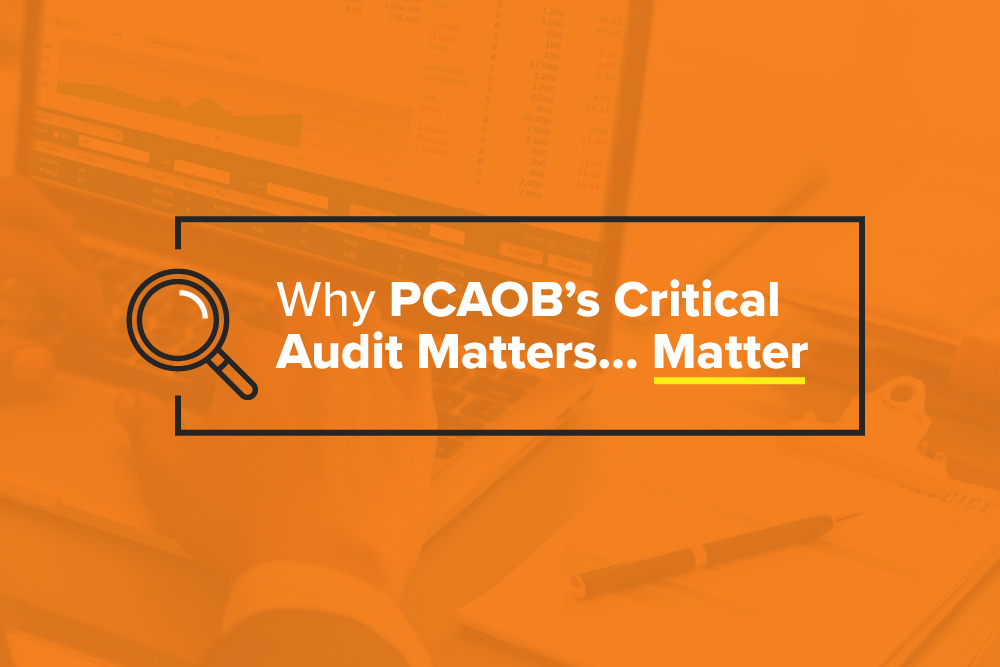Embark prides itself at being on the forefront of change in an industry too often view as static and inflexible. As anyone on the frontlines of accounting, finance, or auditing will tell you, our industry is evolving at a rapid clip, so rapid that all the changes can overwhelm even the most stoic and stout of financial professionals. In other words, this world of ours is anything but dormant.

Just look at the Public Company Accounting Oversight Board (PCAOB) as an example, an organization with a stiff upper lip and even keel if there ever was one. Between the PCAOB’s five-year strategic plan we’ve discussed in the recent past, to AS 3101’s new audit reporting standards, change is afoot in Auditville, our friends, and the fun is just getting started. And if we were to single out one particular concept that embodies that notion, it’s the often-discussed but woefully misunderstood critical audit matter (CAM), defined as: any matter stemming from a financial statement audit that is material to the statements and involves subjective, challenging, or complex auditor judgment. Yes, that’s quite the mouthful.
For lack of a better metaphor, the CAM is like the new kid in school, the one with a mysterious aura shadowing their every step that both intrigues and perplexes their fellow students. Whispers beget innuendo, innuendo morphs into blatant rumor-mongering, and chaos eventually reigns supreme. Obviously, that predicament is untenable at best and unfair to the new kid, so Embark wants to provide some context around CAMs, a little background information if you will, to help your publicly-traded organization get cozier with this mysterious stranger.
For an in-depth, technical discussion regarding CAMs with some abundantly useful best practices to boot, we highly recommend downloading Embark’s guide on the topic, Critical Audit Matters and The Impact on PCAOB Audit Opinion. However, a look at how CAMs figure into the bigger picture will provide useful context to this new and oh-so-important part of the PCAOB audit opinion.
Rooted in the PCAOB’s Mission
One needn’t look any further than the PCAOB’s inception and mission to get a much better understanding of the motives and goals propelling the introduction of CAMs to the audit opinion. The PCAOB itself stems from Sarbanes-Oxley (SOX), a sweeping effort to instill reliability, transparency, and accountability into the audit and financial procedures behind publicly traded entities. In the wake of accounting scandals that shook the stability of our economic infrastructure, SOX and its offspring, the PCAOB, exist to serve a singular group -- stakeholders.
PCAOB’s mission statement further clarifies the impetus behind CAMs in the audit opinion: to oversee the audits of public companies in order to protect the interests of investors and further the public interest in the preparation of informative, accurate, and independent audit reports.
CAMs are rooted in that mission, a tool to provide continued transparency and vital information in an environment that becomes more complex and downright hazy with each passing day. Business is evolving at a velocity never before experienced, where definitions blur into one another and information critical to stakeholders can fog over in a confusing mist.
Think of CAMs as the terry cloth towels that, at least in theory, wipe much of that that fog from the windows, giving investors, employees, and anyone else that relies on sound information a renewed sense of clarity. They’re a new tool for a changing business landscape that perpetuates the goals behind SOX and the PCAOB itself, elevating the traditional pass/fail model to one more inclusive of essential information that otherwise might have fallen by the wayside.
Useful, Not Perfect
Before we become hyperbolic on the virtues of the CAM, a nice dose of reality is well in order. Is the PCAOB well-intentioned with the introduction of CAMs into the audit opinion? Absolutely. At their most fundamental level, CAMs should provide much-needed information on particularly cloudy and complicated matters in a conversational tone that isn’t mired in confusing financial shorthand.
As the old saying goes, however, the road to -- uhh -- a bad place is paved with good intentions. Much has to fall into place for CAMs to meet the PCAOB’s goals and expectations for them. Companies, auditors, and stakeholders alike must understand a CAM’s utility and limits, particularly regarding the subjectivity they’re designed to illuminate and explain. This requires education, planning, and organization, all driven by communication between the entities involved.
Since it’s companies we’re speaking to, though, Embark suggests you begin with a thorough understanding of the new PCAOB audit standards, how CAMs fit into the process, and what it means to you and your business. Now that you see where CAMs come from and how they align with the PCAOB’s mission, the next step is to prepare yourself for their arrival. So on that note, check out Embark’s new guide, Critical Audit Matters and The Impact on PCAOB Audit Opinion, get a clearer lay of the audit land, and proceed with a better sense of direction. Even better, have an ongoing discussion on these matters with your auditor, seek further guidance from their expertise, and never stop learning and improving. As you already know, Embark has your back every step of the way.








